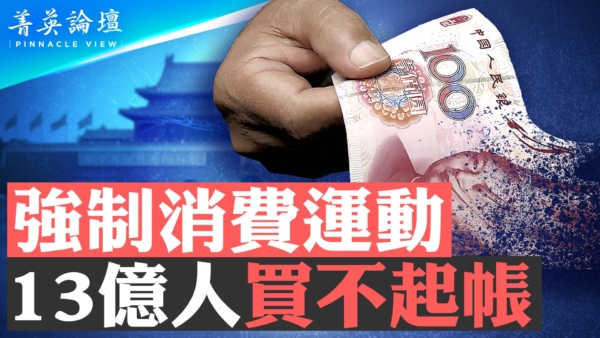【新唐人2013年07月24日讯】近期,一份《中共中央机关财政决算报告》震惊了各界。报告显示,仅2012年,大陆80多个中央机关就消费了9200亿元,超出预算2200亿元。民众纷纷追问,这么多钱究竟花在了什么地方?专家指出,预算、决算相差如此之大,证明中共当局财政预算编制如同儿戏,又因为花的是民众的钱,因此肆意挥霍,才造成超支过度。
7月18号,中共中央80多个部门集中公开2012年度决算,包括“三公”经费、行政经费等数据,绝大多数部门决算远超预算幅度。
所谓部门预算,就是看未来一年“预计花多少钱,怎么花”,决算则是“实际上花了多少钱,怎么花的”。专家指出,预算和决算差别不应该太大,否则就说明花钱随意性太大,这样的预算就没有太大意义。
美国南卡罗莱纳大学艾肯商学院教授谢田:“因为中国共产党向来是高于法律的,各级政府都是这样,他们实际上都没有真正的按照预算来做这预演,它不需要为老百姓负责,也没有人去监督它的权力,它实质上,是把公款消费这些支出、吃喝、旅行这些‘三公消费’算作他们作为官员福利的一部分,它这个预算实际上只能过过场,走走形式而已。”
从决算总额看,花费排在前三名的分别是教育部、税务总局和前卫生部,其中教育部花费近2600亿元,超出预算729.16亿元。按照公布的信息显示:以教育部30万在职人员和近20万的离退休人员来计算,去年教育部的人头费平均每人高达50万元以上。
美国纽约城市大学政治学教授夏明:“最根本的问题在于,中国的‘钱袋子’权力完全由党和国——毫无限制、毫无监督的,一方面掠夺性的在使用﹔第二方面是为特权利益在使用﹔第三,整个使用过程处于黑箱操作。因为它没有监督,所以就没有责任,在这种情况下,它也没有节约概念。”
6月底审计署发布的数据显示,104个中央部门本级有396.4亿元结余结转资金,其中22个部门项目支出结余结转超过当年预算的35%,最高达189%。专家感慨:如果这些钱能投入到民生项目,可以解决多少实际问题!
根据一位曾担任过教育局局长的人大代表统计,每年只需1800亿就可以让全中国的义务教育真正免费,800亿就可以让农村中小学学杂费全免。而全世界193个国家,有170个国家的义务教育免费,其中包括印度。但中共当局却以“教育经费紧张”,成为了世界上少数几个义务教育收费的国家,这不能不说是一个讽刺。
夏明:“如果说西方国家是‘民有、民治、民享’的政府的话,那么中国就变成了‘官有、官治和官享’的政府。”
在中国俗称“因公出国”、“公务车”和“公款招待”为“三公消费”。尽管中共的“三公”经费支出一直备受诟病,但仍逐年递增。
在极大的民怨下,中共领导人习近平出台了一系列控制“三公”消费的新政。于是,在去年度的中央决算报告上,“三公”经费支出比预算减少了5.59亿元。
中国的《千龙网》分析指出,中共官员和政府部门不过是将“三公”消费由明转暗,才出现“三公”费用明显降低,但实际上经费总量不降反增。因为这些钱在账面上都变成了“其他收支”,有些国有机关和地方政府的“其他开支”甚至占总支出的40%。可见中共媒体宣传的所谓“三公消费”明显降低,不过是掩耳盗铃的把戏罢了。
采访/ 常春 编辑/张天宇 后制/萧雨
920 billion a year consumed, where did the money actually go?
Recently, a Chinese Communist Party (CCP) Central Committee Financial Settlement Report shocked the community. It shows that within 2012, 80+ central departments consumed 920 billion yuan, exceeding the budget of 220 billion yuan. People question where exactly that much money was spent.
Experts said that the huge gap between the budget and the actual figure proves financial budgeting is meaningless because it is the public’s money, so profligate spending has caused excessive cost overruns.
On July 18th, more than 80 central departments of the Chinese Communist Party (CCP) published the 2012 annual accounts, including the “three public consumptions," administrative expenses. The majority of the accounts were far over budget.
The purpose of the so-called departmental budgeting is to look at how much money is expected to be spent in the coming year and where it will be spent. Experts say there shouldn’t be a large gap between the budget and final account. If there is random spending, the budget would not make much sense.
Aiken School of Business (USC) Professor Xie Tian: “The Party is always above the law, so are its governments at all levels. They didn’t actually perform according to the budget. It is irresponsible towards the people, no one supervises its power. Essentially, officials count these expenditures, food and drink, travel (three public consumptions) as part of their benefits, so the budget is just for a show and has no actually meaning."
。
The top three of the total accounts are respectively, the Ministry of Education, State Administration of Taxation and the former Ministry of Health; the Ministry of Education spent nearly 260 billion yuan, which was 72.916 billion yuan over budget. As released, the Ministry of Education has 300,000 employees and nearly 200,000 retirees, the average for each person was up to 50 million yuan last year.
NYCU political science professor Xia Ming: “The key point is that the spending power in China is entirely controlled by the party and the regime without restrictions or supervision, predatorily, for privileged interest, in black-box fashion. There is no monitoring, no obligation, so they spend recklessly."
The Audit Commission released data in June showing that 104 central departments with a 39.64 billion yuan surplus of carry-over funds, of which 22 departments expenditure balance carried over 35% of the year’s budget, even up to 189%. Experts feel that if the money can be put into livelihood projects, many practical problems can be solved.
According to a statistic provided by a former deputy of the Education Bureau, 180 billion yuan a year can make compulsory education truly free throughout all of China. 80 billion yuan would allow rural schools to be tuition free in China. There are 193 countries in the world, 170 countries have reached free compulsory education, including India. However, Chinese authorities claim with “education funding tension," it became one of the countries that charges a fee for compulsory education. Isn’t this a satire!
Xia Ming: “If western governments are ‘of the people, by the people, for the people’, then China would be ‘of the officials, by the officials and for the officials.'"
The cost of overseas travel, receptions and official cars are called the “three public consumptions" in China. Although the three public consumptions have long been criticized, spending in that area is still increasing every year.
With great resentment, the Chinese leaders Xi Jinping introduced a series of control of the “three public consumptions." Thus, in last year’s central accounts report, the “three public consumptions” budget was reduced by 559 million yuan.
Qianlong Network experts pointed out that Chinese officials and government departmental spending faded to black. This is why it appears the costs were significantly reduced. Actually, the amount increased rather than reduced, because the money on the books have become other expenses. The other expenses can be 40% of total expenditure in some state or local departments. It tells us that the significantly reduced “three public consumptions” propaganda by the CCP media` is a trick to fool the public.





























